HOME|Ideas and resoueces for planetary science experiments|Making Craters in the Classroom
宇宙の実験教室
Ideas and resoueces for planetary science experiments
カテゴリ
Category
- 実験教室Idea and Resources for Space science experiments
- 対象項目別Category: Contents
- 学年単元別Category: Study Age
-
- 実践授業Activity Reports
タグ
Tag
 クレーターを作ってみよう
クレーターを作ってみよう
ねらい
月や惑星・衛星の表面にたくさんあるクレーター地形が、隕石の衝突によって形成されたものであることを理解しましょう。
月や惑星・衛星の表層には,衝突クレーターが多数あります。これは、隕石などの小天体が表層に衝突して形成した穴です。
これらを学校の教室などで簡単に作る実験を紹介しましょう。
このモデル実験では、隕石に見立てた鉄球を様々な高さからバケツに入れた白砂に落下させることで、隕石落下とクレーター形成の疑似体験をすることができます。
実験方法
用意するもの
箱・砂・鉄球(色々な重さがあるとなお良い)・巻尺・定規・ノギス
標的をつくろう
 箱に砂を入れて、クレーターを作る地面を作ります。
箱に砂を入れて、クレーターを作る地面を作ります。
クレーターを作ってみよう
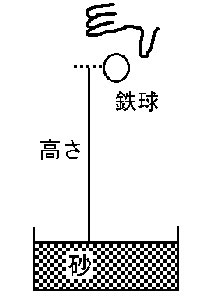 鉄球を砂の上に落とすだけで、小さなクレーター地形を観察することができます。アポロの月面写真のクレーター地形と比較してみましょう。
鉄球を砂の上に落とすだけで、小さなクレーター地形を観察することができます。アポロの月面写真のクレーター地形と比較してみましょう。
衝突エネルギーとクレーター直径の関係を調べよう
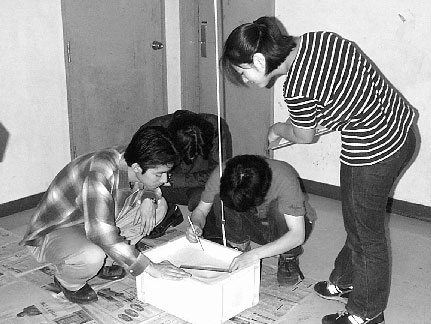 鉄球を落とすときに、鉄球の大きさ・鉄球の重さ・落下の高さ・クレーターの直径を計測し、記録しておきましょう。その結果から衝突エネルギーとクレーター直径の関係を調べてみましょう。
鉄球を落とすときに、鉄球の大きさ・鉄球の重さ・落下の高さ・クレーターの直径を計測し、記録しておきましょう。その結果から衝突エネルギーとクレーター直径の関係を調べてみましょう。
実験結果
砂の上にはどんな地形が作られましたか?
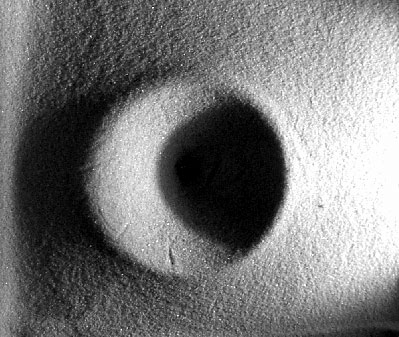 |
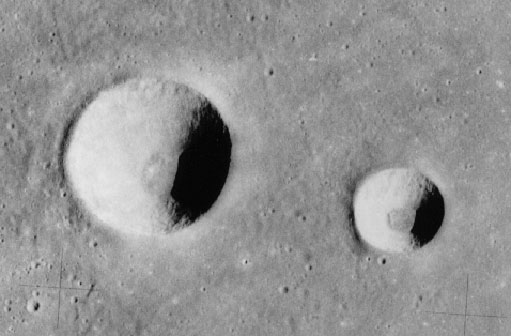 |
| 直径5cmの鉄球を2.5mの高さから落下させて形成したクレーター直径20cmのクレーターができました | 実際の月面クレーターの例 危難の海 内部のクレーター(左)直径12km (右)直径5km アポロの月面写真より |
この写真は鉄球を落として作ったクレータ(左)とアポロの月面写真(右)です。とてもよく似ていますね。
クレーターの大きさと落下距離は隕石の大きさとどのような関係があるのだろう?
鉄球の大きさ・鉄球の重さ・落下の高さ・クレーターの直径 の測定結果から、衝突エネルギーと形成されたクレーターの直径の関係を調べてみましょう。衝突直前の鉄球の運動エネルギーを衝突エネルギーと定義します。そうすると、空気抵抗を無視して、初速度を0としたとき、鉄球の質量と落下の高さ(落下距離)から計算できます。簡便なモデル実験と衝突エネルギーの換算方法ですが、グラフにしてみると、衝突エネルギーと形成されたクレーター直径の間には、正の相関関係があります。
衝突エネルギーに対するクレーターの直径の関係(須田2001より)
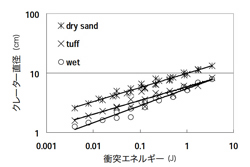 直径、1.0、1.5、2.0、3.0、4.0 cm,密度7800 kg/m3の4種類の鉄球(教材用の市販品)を、0.1-3.2 mの高さから落下させました。
直径、1.0、1.5、2.0、3.0、4.0 cm,密度7800 kg/m3の4種類の鉄球(教材用の市販品)を、0.1-3.2 mの高さから落下させました。
横軸を衝突エネルギー、縦軸をクレーター直径にして実験結果をグラフにすると、上の図で示したように、衝突エネルギーが大きくなるにつれてクレーターの直径が大きくなるという関係がみられます。
この実験では、砂の種類を、乾燥硅砂 dry sand(密度 1600 kg/m3)、乾燥粘土 tuff(密度900kg/m3)、湿潤硅砂 wet(密度 2000 kg/m3)の3種類を使って、砂の種類による違いについても調べ、同様な関係を得られました。
 Making Craters in the Classroom
Making Craters in the Classroom
Introduction
The surface of the Moon and many planetary satellites are covered in craters. These were formed by a large number of impacts by meteorites.
The process by which impact craters are formed will be demonstrated here by means of a simple classroom experiment.
In this experiment, an iron ball, representing a meteorite, is dropped from various heights onto a bucket of white sand, representing the surface of the Moon, to simulate a planetary impact and the formation of a crater. The results of this are then compared with craters observed on the Moon.
Experimental Method
Things to Prepare
You will require a bucket of sand, an iron sphere (ideally have several, with a range of sizes), tape measure, ruler and set of callipers
Preparation of the Target
 Pour the sand into the bucket and ensure the top surface is smooth. This will act as the planetary surface where the crater forms.
Pour the sand into the bucket and ensure the top surface is smooth. This will act as the planetary surface where the crater forms.
Making Craters
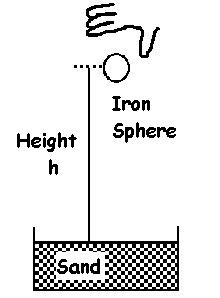 Simply drop the iron sphere onto the sand, and look at the appearance of craters formed in the sand. Use Apollo photos of the lunar surface to compare your craters with those on planetary surfaces.
Simply drop the iron sphere onto the sand, and look at the appearance of craters formed in the sand. Use Apollo photos of the lunar surface to compare your craters with those on planetary surfaces.
Studying the Relationship between Crater Diameter and Impact Energy
 When dropping iron sphere, record the weight of the iron sphere, the height it is dropped above the target, and the diameter of crater formed. With these parameters, investigate the relationship between the energy of the impacting sphere and the crater diameter.
When dropping iron sphere, record the weight of the iron sphere, the height it is dropped above the target, and the diameter of crater formed. With these parameters, investigate the relationship between the energy of the impacting sphere and the crater diameter.
Experimental Results
Were impact craters produced in the sand?
 |
 |
| The crater formed in sand from the impact of a 5cm diameter iron sphere dropped from a height of 2.5m The crater is 20cm across | An Apollo image of pair of craters on the lunar surface, in the Mare Crisium regionThe craters are 12km (left) and 5km (right) in diameter. |
The photographs above show the crater produced by dropping an iron sphere onto sand (left), and an Apollo photograph of craters on the lunar surface (right). The similarity between the craters is obvious.
Is there a relationship between the size and drop height of the impactor and the size of the crater?
From the measurements of the mass and drop height of the iron sphere and the diameter of the impact crater formed, we can determine the relationship between the impact energy and crater size. The impact energy is defined as being the Kinetic energy of the iron sphere immediately before impact. Assuming the initial speed of the impactor to be 0, and ignoring aerodynamic drag, we can obtain the iron sphere's kinetic energy from its mass and its drop height. We are using the results from a very simple experiment, together with a basic calculation of the impact energy, but as will be demonstrated below, a graph of crater diameter versus impact energy displays an excellent correlation.
Finding the relationship between crater diameter and impact energy
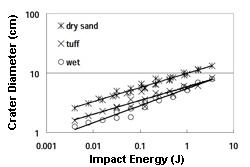 Obtain five iron spheres of 1.0, 1.5, 2.0, 3.0 and 4.0cm diameter, which have density 7800 kg/m3 (these can easily be acquired commercially), and drop them onto sand from heights in range 0.1-3.2m.
Obtain five iron spheres of 1.0, 1.5, 2.0, 3.0 and 4.0cm diameter, which have density 7800 kg/m3 (these can easily be acquired commercially), and drop them onto sand from heights in range 0.1-3.2m.
Then use this data to construct a graph with the x-axis being the impact energy and the y-axis being crater diameter. Your graph should look similar to the one shown on the right. From your graph, you should be able to observe that as the impact energy increases, then so does crater diameter.
In this experiment, iron spheres were dropped onto three different types of sand: dry sand (density 1600 kg/m3), dry clay tuff (density 900kg/m3), and wet sand (density 2000 kg/m3), to look for the effect on the relationship between impact energy and crater diameter. Looking at the graph, the relationship is similar for all three types of sand.











